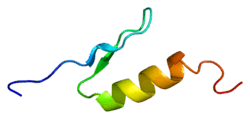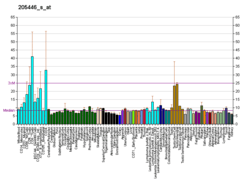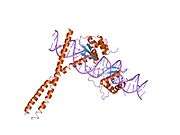Activating transcription factor 2
Activating transcription factor 2, also known as ATF2, is a protein that, in humans, is encoded by the ATF2 gene.[5]
Function
This gene encodes a transcription factor that is a member of the leucine zipper family of DNA-binding proteins. This protein binds to the cAMP-responsive element (CRE), an octameric palindrome. The protein forms a homodimer or heterodimer with c-Jun and stimulates CRE-dependent transcription. The protein is also a histone acetyltransferase (HAT) that specifically acetylates histones H2B and H4 in vitro; thus, it may represent a class of sequence-specific factors that activate transcription by direct effects on chromatin components. Additional transcript variants have been identified but their biological validity has not been determined.[5]
The gene atf2 is located at human chromosome 2q32.[6] The protein ATF-2 has 505 amino acids. Studies in mice indicate a role for ATF-2 in the development of nervous system and the skeleton.[7] ATF-2 is normally activated in response to signals that converge on stress-activated protein kinases p38 and JNK.[8] ATF-2 phosphorylation in response to treatment of cells with tumor promoter phorbol ester has been demonstrated.[9]
Several studies implicate abnormal activation of ATF-2 in growth and progression of mammalian skin tumors.[10][11] ATF-2 may mediate oncogenesis caused by mutant Ras protein[12] and regulate maintenance of the aggressive cancer phenotype of some types of epithelial cells. ATF2 has also been shown to be phosphorylated at its C-terminal (Serine 472 and 480 in mouse; Serine 490 and 498 in human) by ATM upon double-stranded breaks. Mice with mutations of these two serines are sensitive to irradiation and easier to tumorigenesis under p53 knockout background.
ATF2 has also been shown to be phosphorylated at its C-terminal (serine 472 and 480 in mouse; serine 490 and 498 in human) by ATM upon double-stranded breaks.[13]
Interactions
Activating transcription factor 2 has been shown to interact with
See also
References
- 1 2 3 GRCh38: Ensembl release 89: ENSG00000115966 - Ensembl, May 2017
- 1 2 3 GRCm38: Ensembl release 89: ENSMUSG00000027104 - Ensembl, May 2017
- ↑ "Human PubMed Reference:".
- ↑ "Mouse PubMed Reference:".
- 1 2 "Entrez Gene: ATF2 activating transcription factor 2".
- ↑ Ozawa K, Sudo T, Soeda E, Yoshida MC, Ishii S (1991). "Assignment of the human CREB2 (CRE-BP1) gene to 2q32". Genomics. 10 (4): 1103–4. doi:10.1016/0888-7543(91)90210-6. PMID 1833307.
- ↑ Reimold AM, Grusby MJ, Kosaras B, Fries JW, Mori R, Maniwa S, Clauss IM, Collins T, Sidman RL, Glimcher MJ, Glimcher LH (1996). "Chondrodysplasia and neurological abnormalities in ATF-2-deficient mice". Nature. 379 (6562): 262–5. doi:10.1038/379262a0. PMID 8538792.
- ↑ Gupta S, Campbell D, Dérijard B, Davis RJ (1995). "Transcription factor ATF2 regulation by the JNK signal transduction pathway". Science. 267 (5196): 389–93. doi:10.1126/science.7824938. PMID 7824938.
- ↑ Yamasaki T, Takahashi A, Pan J, Yamaguchi N, Yokoyama KK (March 2009). "Phosphorylation of Activation Transcription Factor-2 at Serine 121 by Protein Kinase C Controls c-Jun-mediated Activation of Transcription". J. Biol. Chem. 284 (13): 8567–81. doi:10.1074/jbc.M808719200. PMC 2659215. PMID 19176525.
- ↑ Leslie MC, Bar-Eli M (2005). "Regulation of gene expression in melanoma: new approaches for treatment". J. Cell. Biochem. 94 (1): 25–38. doi:10.1002/jcb.20296. PMID 15523674.
- ↑ Papassava P, Gorgoulis VG, Papaevangeliou D, Vlahopoulos S, van Dam H, Zoumpourlis V (2004). "Overexpression of activating transcription factor-2 is required for tumor growth and progression in mouse skin tumors". Cancer Res. 64 (23): 8573–84. doi:10.1158/0008-5472.CAN-03-0955. PMID 15574764.
- ↑ Vlahopoulos SA, Logotheti S, Mikas D, Giarika A, Gorgoulis V, Zoumpourlis V (17 March 2008). "The role of ATF-2 in oncogenesis". BioEssays. 30 (4): 314–27. doi:10.1002/bies.20734. PMID 18348191.
- ↑ Bhoumik A, Takahashi S, Breitweiser W, Shiloh Y, Jones N, Ronai Z (May 2005). "ATM-dependent phosphorylation of ATF2 is required for the DNA damage response". Mol. Cell. 18 (5): 577–87. doi:10.1016/j.molcel.2005.04.015. PMC 2954254. PMID 15916964.
- ↑ Newell CL, Deisseroth AB, Lopez-Berestein G (July 1994). "Interaction of nuclear proteins with an AP-1/CRE-like promoter sequence in the human TNF-alpha gene". J. Leukoc. Biol. 56 (1): 27–35. PMID 8027667.
- ↑ Kara CJ, Liou HC, Ivashkiv LB, Glimcher LH (April 1990). "A cDNA for a human cyclic AMP response element-binding protein which is distinct from CREB and expressed preferentially in brain". Mol. Cell. Biol. 10 (4): 1347–57. PMC 362236. PMID 2320002.
- ↑ Hai T, Curran T (May 1991). "Cross-family dimerization of transcription factors Fos/Jun and ATF/CREB alters DNA binding specificity". Proc. Natl. Acad. Sci. U.S.A. 88 (9): 3720–4. doi:10.1073/pnas.88.9.3720. PMC 51524. PMID 1827203.
- 1 2 Yamaguchi Y, Wada T, Suzuki F, Takagi T, Hasegawa J, Handa H (August 1998). "Casein kinase II interacts with the bZIP domains of several transcription factors". Nucleic Acids Res. 26 (16): 3854–61. doi:10.1093/nar/26.16.3854. PMC 147779. PMID 9685505.
- ↑ Sano Y, Tokitou F, Dai P, Maekawa T, Yamamoto T, Ishii S (October 1998). "CBP alleviates the intramolecular inhibition of ATF-2 function". J. Biol. Chem. 273 (44): 29098–105. doi:10.1074/jbc.273.44.29098. PMID 9786917.
- ↑ Murata T, Shinozuka Y, Obata Y, Yokoyama KK (May 2008). "Phosphorylation of two eukaryotic transcription factors, Jun dimerization protein 2 and activation transcription factor 2, in Escherichia coli by Jun N-terminal kinase 1". Anal. Biochem. 376 (1): 115–21. doi:10.1016/j.ab.2008.01.038. PMID 18307971.
- 1 2 Raingeaud J, Gupta S, Rogers JS, Dickens M, Han J, Ulevitch RJ, Davis RJ (March 1995). "Pro-inflammatory cytokines and environmental stress cause p38 mitogen-activated protein kinase activation by dual phosphorylation on tyrosine and threonine". J. Biol. Chem. 270 (13): 7420–6. doi:10.1074/jbc.270.13.7420. PMID 7535770.
- 1 2 Chen Z, Cobb MH (May 2001). "Regulation of stress-responsive mitogen-activated protein (MAP) kinase pathways by TAO2". J. Biol. Chem. 276 (19): 16070–5. doi:10.1074/jbc.M100681200. PMID 11279118.
- 1 2 Tournier C, Whitmarsh AJ, Cavanagh J, Barrett T, Davis RJ (July 1997). "Mitogen-activated protein kinase kinase 7 is an activator of the c-Jun NH2-terminal kinase". Proc. Natl. Acad. Sci. U.S.A. 94 (14): 7337–42. doi:10.1073/pnas.94.14.7337. PMC 23822. PMID 9207092.
- ↑ Fuchs SY, Xie B, Adler V, Fried VA, Davis RJ, Ronai Z (December 1997). "c-Jun NH2-terminal kinases target the ubiquitination of their associated transcription factors". J. Biol. Chem. 272 (51): 32163–8. doi:10.1074/jbc.272.51.32163. PMID 9405416.
- ↑ Sano Y, Harada J, Tashiro S, Gotoh-Mandeville R, Maekawa T, Ishii S (March 1999). "ATF-2 is a common nuclear target of Smad and TAK1 pathways in transforming growth factor-beta signaling". J. Biol. Chem. 274 (13): 8949–57. doi:10.1074/jbc.274.13.8949. PMID 10085140.
- ↑ Hong S, Choi HM, Park MJ, Kim YH, Choi YH, Kim HH, Choi YH, Cheong J (April 2004). "Activation and interaction of ATF2 with the coactivator ASC-2 are responsive for granulocytic differentiation by retinoic acid". J. Biol. Chem. 279 (17): 16996–7003. doi:10.1074/jbc.M311752200. PMID 14734562.
- ↑ Cho SG, Bhoumik A, Broday L, Ivanov V, Rosenstein B, Ronai Z (December 2001). "TIP49b, a regulator of activating transcription factor 2 response to stress and DNA damage". Mol. Cell. Biol. 21 (24): 8398–413. doi:10.1128/MCB.21.24.8398-8413.2001. PMC 100004. PMID 11713276.
- ↑ Firestein R, Feuerstein N (March 1998). "Association of activating transcription factor 2 (ATF2) with the ubiquitin-conjugating enzyme hUBC9. Implication of the ubiquitin/proteasome pathway in regulation of ATF2 in T cells". J. Biol. Chem. 273 (10): 5892–902. doi:10.1074/jbc.273.10.5892. PMID 9488727.
External links
- Human ATF2 genome location and ATF2 gene details page in the UCSC Genome Browser.
Further reading
- Denys H, Desmet R, Stragier M, Vergison R, Lemahieu SF (1977). "Cystitis emphysematosa". Acta Urol Belg. 45 (4): 327–31. PMID 602896.
- Kim SJ, Wagner S, Liu F, O'Reilly MA, Robbins PD, Green MR (1992). "Retinoblastoma gene product activates expression of the human TGF-beta 2 gene through transcription factor ATF-2". Nature. 358 (6384): 331–4. doi:10.1038/358331a0. PMID 1641004.
- Hai T, Curran T (1991). "Cross-family dimerization of transcription factors Fos/Jun and ATF/CREB alters DNA binding specificity". Proc. Natl. Acad. Sci. U.S.A. 88 (9): 3720–4. doi:10.1073/pnas.88.9.3720. PMC 51524. PMID 1827203.
- Hoeffler JP, Lustbader JW, Chen CY (1991). "Identification of multiple nuclear factors that interact with cyclic adenosine 3',5'-monophosphate response element-binding protein and activating transcription factor-2 by protein-protein interactions". Mol. Endocrinol. 5 (2): 256–66. doi:10.1210/mend-5-2-256. PMID 1828107.
- Ozawa K, Sudo T, Soeda E, Yoshida MC, Ishii S (1991). "Assignment of the human CREB2 (CRE-BP1) gene to 2q32". Genomics. 10 (4): 1103–4. doi:10.1016/0888-7543(91)90210-6. PMID 1833307.
- Diep A, Li C, Klisak I, Mohandas T, Sparkes RS, Gaynor R, Lusis AJ (1991). "Assignment of the gene for cyclic AMP-response element binding protein 2 (CREB2) to human chromosome 2q24.1-q32". Genomics. 11 (4): 1161–3. doi:10.1016/0888-7543(91)90047-I. PMID 1838349.
- Kara CJ, Liou HC, Ivashkiv LB, Glimcher LH (1990). "A cDNA for a human cyclic AMP response element-binding protein which is distinct from CREB and expressed preferentially in brain". Mol. Cell. Biol. 10 (4): 1347–57. PMC 362236. PMID 2320002.
- Gonzalez GA, Yamamoto KK, Fischer WH, Karr D, Menzel P, Biggs W, Vale WW, Montminy MR (1989). "A cluster of phosphorylation sites on the cyclic AMP-regulated nuclear factor CREB predicted by its sequence". Nature. 337 (6209): 749–52. doi:10.1038/337749a0. PMID 2521922.
- Maekawa T, Sakura H, Kanei-Ishii C, Sudo T, Yoshimura T, Fujisawa J, Yoshida M, Ishii S (1989). "Leucine zipper structure of the protein CRE-BP1 binding to the cyclic AMP response element in brain". EMBO J. 8 (7): 2023–8. PMC 401081. PMID 2529117.
- Raingeaud J, Gupta S, Rogers JS, Dickens M, Han J, Ulevitch RJ, Davis RJ (1995). "Pro-inflammatory cytokines and environmental stress cause p38 mitogen-activated protein kinase activation by dual phosphorylation on tyrosine and threonine". J. Biol. Chem. 270 (13): 7420–6. doi:10.1074/jbc.270.13.7420. PMID 7535770.
- Livingstone C, Patel G, Jones N (1995). "ATF-2 contains a phosphorylation-dependent transcriptional activation domain". EMBO J. 14 (8): 1785–97. PMC 398272. PMID 7737129.
- van Dam H, Wilhelm D, Herr I, Steffen A, Herrlich P, Angel P (1995). "ATF-2 is preferentially activated by stress-activated protein kinases to mediate c-jun induction in response to genotoxic agents". EMBO J. 14 (8): 1798–811. PMC 398273. PMID 7737130.
- Zhou Q, Gedrich RW, Engel DA (1995). "Transcriptional repression of the c-fos gene by YY1 is mediated by a direct interaction with ATF/CREB". J. Virol. 69 (7): 4323–30. PMC 189172. PMID 7769693.
- Newell CL, Deisseroth AB, Lopez-Berestein G (1994). "Interaction of nuclear proteins with an AP-1/CRE-like promoter sequence in the human TNF-alpha gene". J. Leukoc. Biol. 56 (1): 27–35. PMID 8027667.
- Nomura N, Zu YL, Maekawa T, Tabata S, Akiyama T, Ishii S (1993). "Isolation and characterization of a novel member of the gene family encoding the cAMP response element-binding protein CRE-BP1". J. Biol. Chem. 268 (6): 4259–66. PMID 8440710.
- Martin ML, Lieberman PM, Curran T (1996). "Fos-Jun dimerization promotes interaction of the basic region with TFIIE-34 and TFIIF". Mol. Cell. Biol. 16 (5): 2110–8. PMC 231198. PMID 8628277.
- Yang L, Lanier ER, Kraig E (1997). "Identification of a novel, spliced variant of CREB that is preferentially expressed in the thymus". J. Immunol. 158 (6): 2522–5. PMID 9058782.
- Shuman JD, Cheong J, Coligan JE (1997). "ATF-2 and C/EBPalpha can form a heterodimeric DNA binding complex in vitro. Functional implications for transcriptional regulation". J. Biol. Chem. 272 (19): 12793–800. doi:10.1074/jbc.272.19.12793. PMID 9139739.
- Fukunaga R, Hunter T (1997). "MNK1, a new MAP kinase-activated protein kinase, isolated by a novel expression screening method for identifying protein kinase substrates". EMBO J. 16 (8): 1921–33. doi:10.1093/emboj/16.8.1921. PMC 1169795. PMID 9155018.
- Kumar S, McDonnell PC, Gum RJ, Hand AT, Lee JC, Young PR (1997). "Novel homologues of CSBP/p38 MAP kinase: activation, substrate specificity and sensitivity to inhibition by pyridinyl imidazoles". Biochem. Biophys. Res. Commun. 235 (3): 533–8. doi:10.1006/bbrc.1997.6849. PMID 9207191.








